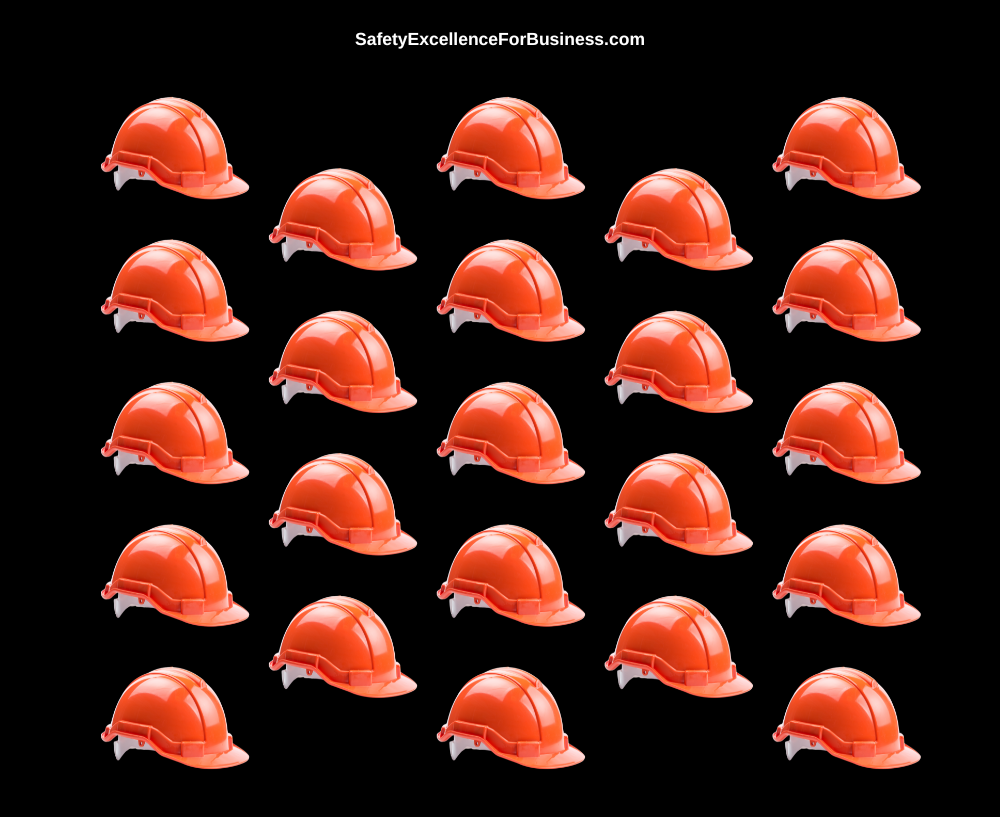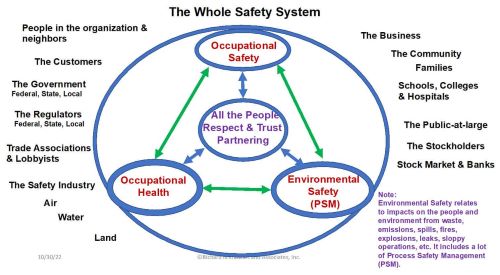Indifference… At a local event this past week, I asked a friend who is involved in safety work the question, why are people getting killed at work? He quickly came up with this answer.
“A lot fewer people are being killed than it used to be before OSHA. There has been a lot of progress. We must be at about the best we can do.“
Then the conversation moved off to the Olympics. He just brushed this off as no longer important.
But this is important to the approximately 5,200 families who have had someone in their family killed. This experience remains with the family forever. And this 5,200 total number is an every year statistic!
Those of you reading my newsletters know that I am constantly trying to help people reduce injuries and deaths by building Partner-Centered Leadership and sharing real case studies that have been published in Professional Safety. We can reduce the numbers of injuries and fatalities, and we shouldn’t just push this problem aside with indifference.

Leaders Lacking Insights About What Is Possible
At a recent graduation celebration gathering, I was talking with a family member who has a very responsible safety leadership job in a large company, about my efforts to have fewer people killed at work. We talked about Partner-Centered Leadership and having everyone involved, co-creating our shared futures and taking more responsibility for the whole business efforts, including safety.
I was asked, “How do you work this way across widely dispersed sites?” This is a challenge for sure. The way I see it, this effort has to begin with the CEO and the Leadership Team. They need to talk about Partner-Centered Leadership and walk the talk at every site visit so people can understand that they mean it. The top people need to personally engage the lower levels in learning to lead this way and insist that everyone is involved. The CEO and Leadership Team should do some of the training of the lower-level people.
If someone does not get on board, then some tough decisions need to be made. The message should be that this is the way the company is going to do business going forward. But equally important is helping everyone to see that going home to one’s family at the end of the workday with all one’s body parts intact – no injuries, no incidents, is the absolute answer to What’s in it for me?
My mantra when I was a plant manager was, “I don’t have a right to make my living where it is okay for you to get hurt!” Does anyone have this right? The methodology for success is to engage people – for supervision across the board, up and down the organization to learn how to ask process questions. When it comes to safety, leaders who are in denial, or pretending one “doesn’t know” just doesn’t cut it. Asking process questions can ensure accountability.
We then talked about why there was so much resistance to these ideas. Based on some hard systems thinking, I think that the whole US safety industry with all the training, audits, fines, blame, etc. is driven by FEAR! This idea can be startling. Examining safety from a systems perspective was a different idea – particularly noting that fear was a key driver.
The problem with a culture being driven by fear is that it is very difficult to learn and do new things. Just about everyone is concentrated on covering their backside rather than talking together in an environment that is safe enough to explore new ideas together. When we work together using Partner-Centered Leadership, we can open up the vast knowledge that is lying hidden in our organizations. When we treat people with respect, listen and learn together, amazing new ideas and possibilities bubble up.
Everything changes! Productivity goes up. Earnings go up, Safety improves. The culture becomes one where almost everyone is learning, growing, taking more responsibility and producing great results. New possibilities emerge which often lead to much better earnings.

Partner-Centered Leadership
When the CEO and the Leadership Team learn what is possible and how to work this way with authenticity and caring, this can spread throughout their organization and achieve significantly better results. It takes some effort and dedication, but there is no need for new capital investment. In a sense, Partner-Centered Leadership is free!






 A review of the Bureau of Labor Statics summary of fatal occupational injuries for 2011-2017 shows a 1% drop in fatalities from 2016 to 2017 to a total of 5,147 people having lost their lives at work. This is about 9% higher than the 4,693 people killed in 2011. The top three 2017 fatalities categories are roadway accidents totaling 1,299 (up 15% since 2011); slips, trips and falls totaling 887 (up 23% since 2011); and murders and suicides totaling 733 (up by only 2% since 2011).
A review of the Bureau of Labor Statics summary of fatal occupational injuries for 2011-2017 shows a 1% drop in fatalities from 2016 to 2017 to a total of 5,147 people having lost their lives at work. This is about 9% higher than the 4,693 people killed in 2011. The top three 2017 fatalities categories are roadway accidents totaling 1,299 (up 15% since 2011); slips, trips and falls totaling 887 (up 23% since 2011); and murders and suicides totaling 733 (up by only 2% since 2011). We need courageous leaders who focus on the people, change and the future. Leaders value sharing information, building trust and interdependence, and helping people to see how their job is important for the success of the whole venture.
We need courageous leaders who focus on the people, change and the future. Leaders value sharing information, building trust and interdependence, and helping people to see how their job is important for the success of the whole venture. Go into your organizations listening to and talking with the people. Share your vision. Build trust and interdependence. Create safe spaces for people to talk with each other, to share and create the future. Everything will change. That is what I experienced at the Belle Plant.
Go into your organizations listening to and talking with the people. Share your vision. Build trust and interdependence. Create safe spaces for people to talk with each other, to share and create the future. Everything will change. That is what I experienced at the Belle Plant. At our exhibit booth, Claire and I shared our Partner-Centered Leadership approach. We handed out brochures and other literature that can help organization’s achieve safety excellence and move towards their OSHA Star designation. We were there to share important information, including the need to be able to lift up and address one’s safety elephants that are preventing organizations from being the best they can be.
At our exhibit booth, Claire and I shared our Partner-Centered Leadership approach. We handed out brochures and other literature that can help organization’s achieve safety excellence and move towards their OSHA Star designation. We were there to share important information, including the need to be able to lift up and address one’s safety elephants that are preventing organizations from being the best they can be. The keys for addressing both of these concerns in building sustainability into their programs and in achieving the OSHA Star status is for the people at all levels and parts of the organization to talk together to get clear and aligned on just what they really want to do. How sincere and authentic is the desire to have safety excellence for the long-term? (This means Communication with a Capital C—requiring Co-creation, Clarity and Coherence.) In addition, together they must take the time to co-create a set of ground rules about how they agree to work together in order to achieve their safety goals and then hold each other accountable to live up to them. (That’s Partnership and Commitment!) The process to achieve this is available to you and your organizations now.
The keys for addressing both of these concerns in building sustainability into their programs and in achieving the OSHA Star status is for the people at all levels and parts of the organization to talk together to get clear and aligned on just what they really want to do. How sincere and authentic is the desire to have safety excellence for the long-term? (This means Communication with a Capital C—requiring Co-creation, Clarity and Coherence.) In addition, together they must take the time to co-create a set of ground rules about how they agree to work together in order to achieve their safety goals and then hold each other accountable to live up to them. (That’s Partnership and Commitment!) The process to achieve this is available to you and your organizations now. This is all about having everyone go home in one piece and having a profitable business. Excellence in both the safety performance and business results are attainable.
This is all about having everyone go home in one piece and having a profitable business. Excellence in both the safety performance and business results are attainable. Talking together is one of the most important things we can do to help to improve the safety in our workplaces. Letting people know that you care about them and respect them. But too many times I have seen supervisors and managers talking down to their employees ordering them to do this or that.
Talking together is one of the most important things we can do to help to improve the safety in our workplaces. Letting people know that you care about them and respect them. But too many times I have seen supervisors and managers talking down to their employees ordering them to do this or that. In reading the various, publicly-available reports, it looks as if all three of these big mistakes were probably made. The push for production was dominant, piping changes had been made without documentation, the safety procedures were modified or ignored, operating problems were not properly addressed and tolerated, previous practices allowed the draining of small quantities of material right into the room, and the communications were such that people probably could not or would not tell their management, who probably were not listening anyway, all the problems.
In reading the various, publicly-available reports, it looks as if all three of these big mistakes were probably made. The push for production was dominant, piping changes had been made without documentation, the safety procedures were modified or ignored, operating problems were not properly addressed and tolerated, previous practices allowed the draining of small quantities of material right into the room, and the communications were such that people probably could not or would not tell their management, who probably were not listening anyway, all the problems. At a recent safety conference I learned about a way to quickly assess whether a manufacturing site was cutting corners and trying to get by on less than the best. The person speaking, Ewan Alexander of BHP Billiton, said that he looked for improvised tools being used.
At a recent safety conference I learned about a way to quickly assess whether a manufacturing site was cutting corners and trying to get by on less than the best. The person speaking, Ewan Alexander of BHP Billiton, said that he looked for improvised tools being used.  Each of us, as we travel to and from our work spaces want to be “safe and sound”—we want to return at the end of the day or at the end of our work-shift to our loved ones—safe and sound.
Each of us, as we travel to and from our work spaces want to be “safe and sound”—we want to return at the end of the day or at the end of our work-shift to our loved ones—safe and sound. 




